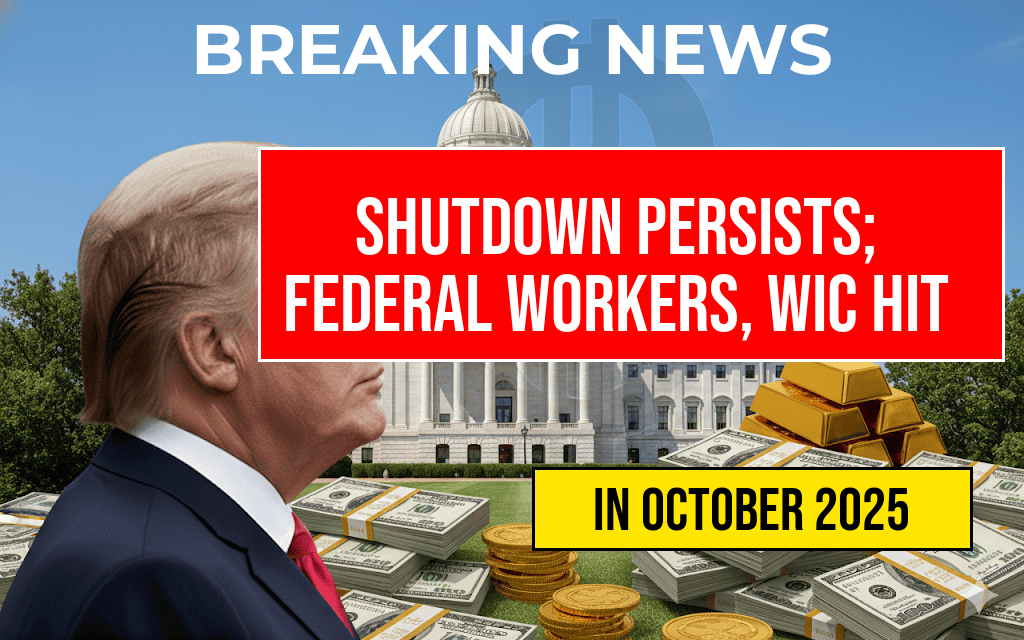Shutdown Continues on Day 6 as Federal Employees Face No Paychecks and $8 Billion WIC Program Faces Cuts
The ongoing federal government shutdown enters its sixth day Saturday, leaving hundreds of thousands of federal employees without pay and significantly impacting vital social programs. Among the most vulnerable affected are women and children enrolled in the Women, Infants, and Children (WIC) program, which faces an $8 billion reduction in funding. With agencies operating under partial or complete shutdown, federal workers are navigating their fourth consecutive day without pay, raising concerns over financial stability and public service disruptions. Meanwhile, negotiations on Capitol Hill remain deadlocked, intensifying fears that the impasse could extend into a second week and further threaten essential services across the country.
Federal Employees and Economic Fallout
Approximately 400,000 federal workers are furloughed, and another 200,000 are working without pay, according to the Office of Management and Budget. The shutdown stems from a political stalemate over budget allocations and policy disputes, primarily centered around immigration, border security, and spending priorities. Many federal employees have expressed mounting anxiety over missed mortgage payments, inability to cover daily expenses, and uncertainty about when they will receive back pay.
The economic impact extends beyond federal employees. Local economies in Washington D.C., and regions heavily reliant on federal agencies, have reported declines in retail sales, restaurant bookings, and service industry earnings. Small businesses that contract with government agencies are also feeling the pinch, with some warning of layoffs if the shutdown persists.
Impact on the WIC Program and Vulnerable Populations
One of the most concerning consequences of the shutdown is its threat to WIC, a federal assistance program that provides nutrition support to nearly 6 million women, infants, and young children nationwide. The program’s funding, which typically sustains operations through the fiscal year, faces an $8 billion shortfall, jeopardizing benefits for families relying on its services. According to the USDA, if the shutdown continues, states may need to impose temporary cuts or delay certain benefits, disrupting access to critical nutrition and health support for vulnerable populations.
“WIC is essential for ensuring healthy development in early childhood, especially in communities facing economic hardship,” said Dr. Lisa Fernandez, a pediatric nutritionist. “Interruptions in WIC benefits can have long-term health consequences for children.”
| Program | Funds Affected | Potential Consequences |
|---|---|---|
| Federal Employee Salaries | Approximately $4 billion | Furloughs, delayed paychecks, financial hardship |
| WIC | $8 billion | Benefit reductions, delays in issuing benefits, increased food insecurity |
| Other Social Services | Variable | Disruptions in housing assistance, food programs, and healthcare services |
Political Deadlock and Next Steps
Negotiations on Capitol Hill have stalled, with Democrats and Republicans pointing fingers over responsibility for the shutdown. Democrats demand certain policy concessions, while Republicans emphasize spending caps and border security measures. Speaker Kevin McCarthy and President Joe Biden remain at an impasse, with neither side showing signs of compromising soon.
Congressional leaders are scheduled to meet again Saturday afternoon, but analysts warn that without a breakthrough, the shutdown could extend beyond a week, further exacerbating economic and social disruptions. The White House has urged lawmakers to prioritize reopening government functions, emphasizing the harm caused to federal workers and vulnerable populations.
Public Response and Broader Implications
Public opinion polls indicate growing frustration among Americans, with many expressing concern over the prolonged shutdown’s impact on their livelihoods and public services. Advocacy groups representing federal employees and social programs have called for swift action, warning of long-term repercussions if the deadlock persists.
- Federal employees: Facing financial strain, stress, and uncertainty about future paychecks.
- Vulnerable families: at risk of losing access to essential nutrition and health services.
- Local economies: Suffering from reduced spending and business closures tied to federal activity.
The shutdown also raises broader questions about government funding processes and the political climate’s impact on essential services. Experts suggest that a long-term resolution will require bipartisan cooperation and reforms to prevent future impasses.
For now, federal workers and programs like WIC remain in limbo, underscoring the urgent need for lawmakers to find common ground. As negotiations continue, the nation watches closely, aware that the consequences of this shutdown extend far beyond Capitol Hill.
Frequently Asked Questions
What is the current status of the government shutdown after Day 6?
The government shutdown is ongoing into its sixth day, with federal agencies remaining partially or fully closed. Federal employees are still facing no paychecks, and essential services continue to be affected.
How are federal employees being impacted by the shutdown?
Federal employees are not receiving their paychecks during the shutdown, which has created financial stress for many workers. Some employees are working without pay, while others have been furloughed, impacting government operations and services.
What are the implications for the WIC program due to the shutdown?
The $8 billion WIC program faces significant funding cuts because of the shutdown, which could reduce nutrition assistance for women, infants, and children. This may lead to disruptions in essential nutritional support for vulnerable populations.
What are the main reasons behind the continuation of the shutdown?
The shutdown persists mainly due to impasses in congressional negotiations, often related to disagreements over federal funding priorities and budget agreements. Without a bipartisan deal, the shutdown remains in effect.
Is there any expected timeline or resolution for the shutdown?
There is currently no clear timeline for resolution. Lawmakers continue to debate, and negotiations are ongoing. Federal employees and programs remain affected until a budget agreement or funding bill is reached.

Leave a Reply